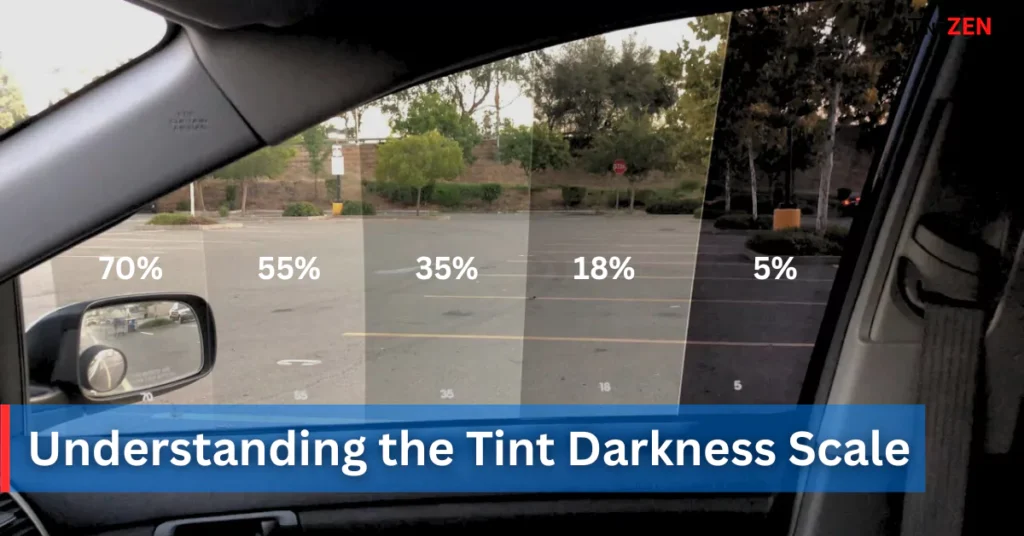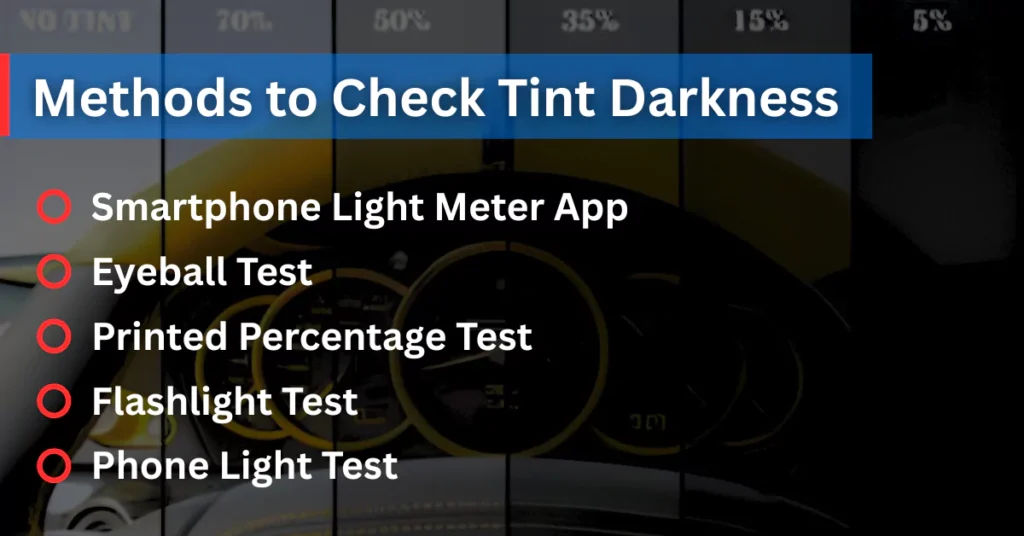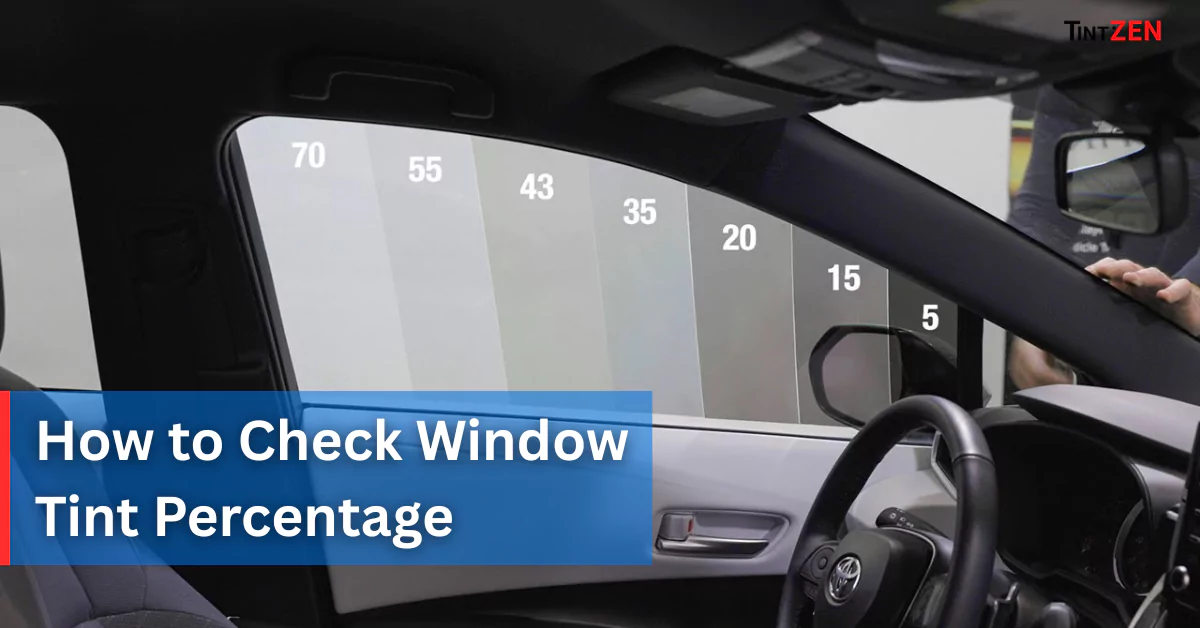Ever wondered if your tinted windows are too dark or if they meet legal limits? Window tint laws are based on visible light transmission (VLT), which measures how much light passes through your glass. The darker the tint, the lower the VLT.
Many drivers enjoy window tinting for its UV protection, glare reduction, and privacy benefits, but not everyone knows how to check their tint correctly. You can measure your tint percentage using a tint meter, smartphone app, or built-in light sensor—these tools compare internal and external light levels to determine transparency.
Knowing your tint percentage helps you stay compliant and make informed choices when selecting the right film. Whether you’re considering new tint or checking your current one, understanding the process can save you from fines and ensure a safer drive.
Understanding the Tint Darkness Scale
The tint darkness scale measures how much Visible Light Transmission (VLT%) passes through your car windows. A higher VLT% lets in more light, making the tint lighter, while a lower VLT% makes it darker.
Authorities use this to ensure safe visibility for drivers. In Australia, tint laws vary by state. Generally, front windows must have at least 35% VLT, while rear windows can be darker. For example:
- South Australia (SA): Rear side windows need 20% VLT
- Northern Territory (NT): Can go as dark as 15% VLT
Other states like NSW, VIC, ACT, QLD, WA, and TAS have different rules, so checking local regulations is key before applying a tint film.

Many people get window tinting for privacy, heat reduction, and UV protection. It also:
- Prevents interior fading by blocking harmful UV rays
- Enhances car aesthetics while keeping it cooler inside
A 90% VLT tint is nearly clear, while a 5% VLT tint is very dark. Going too dark can lead to legal trouble, so always check laws before driving with tinted windows! 🚗
How to Check Window Tint Percentage
Using Tint Meter
If you want to check how dark your window tint is, the most accurate way is to use a tint meter. This device measures Visible Light Transmission (VLT%), showing how much light passes through the tinted glass.
Law enforcement officers and tint installers rely on these meters to ensure tint percentage follows legal limits.
There are two main types of tint meters:
- Horseshoe Design Meters – These are affordable and easy to use. You roll down your window, place the U-shaped meter over the edge, and get a reading. However, they cannot measure rear windows or windshields.
- Two-Piece Meters – These overcome limitations of horseshoe meters by measuring almost any flat glass. Though more expensive, they provide a detailed VLT percentage reading.
To use a tint meter, follow these steps:
- Clean the window to remove dirt, which can affect accuracy.
- Position the meter properly against the window pane, ensuring no gaps for excess light.
- Turn on the meter and allow it to calibrate.
- Check the display for the VLT percentage.
- Take multiple readings across different panes.
- Calculate the average percentage to get an accurate result.
Calculating Tint Darkness Before Applying Film
If you’re planning to apply window tint and want to know how dark it will be, you can use a simple formula to calculate the final VLT percentage.
Step 1: Convert VLT Percentages to Decimals
Each tint percentage needs to be converted into a decimal by dividing by 100:
- Tint VLT: If the film is 50% VLT, convert it to 0.50.
- Original Glass VLT: If the factory glass is 90% VLT, convert it to 0.90.
Step 2: Multiply the Decimals
Now, multiply the tint’s decimal value by the original glass’s decimal value:
- Example: 0.50 (tint) × 0.90 (glass) = 0.45.
Step 3: Convert Back to a Percentage
Multiply the result by 100 to get the final VLT percentage:
- 0.45 × 100 = 45% VLT.
This means your tinted windows will allow 45% of visible light to pass through.
Real-World Examples
- Example 1: A 50% tint on 90% factory glass results in 45% VLT, keeping the tint lighter.
- Example 2: A 35% tint on 88% glass results in 30.8% VLT, making it darker.
By using tint meters or calculating VLT manually, you can ensure your tint meets legal requirements and achieves the desired darkness level.
You Want To Know About How To Fix Bubbles in Window
Why Calculating Window Tint Darkness Matters
Choosing the Right Tint
Selecting the correct tint level ensures your windows match your style while providing the desired shade and privacy.
Legal Compliance
Different states have specific laws regarding window tint darkness. Staying within the legal limit helps you avoid fines and potential penalties.
Visibility and Safety
A darker tint can reduce visibility, especially at night. Knowing your tint percentage helps balance safety and aesthetics for a better driving experience.
Comfort and Protection
Window tints provide UV protection and help with heat reduction, keeping your car cooler and shielding you from harmful rays.
Alternative Methods to Measure Tint Darkness
Using a Smartphone Light Meter App
A smartphone light meter app can measure light transmission through your tinted windows. These apps work by using the phone’s camera, making them convenient but not always reliable.

Factors like lighting conditions and camera quality can affect accuracy. Always take these results with a grain of salt.
Eyeball Test
This method involves checking the clarity of a tinted window compared to an untinted one. While not precise, it gives a rough idea of the tint percentage.
Printed Percentage Test
Print out rectangles with different shading percentages and compare them against your tinted windows. This can help estimate how dark the tint is.
Flashlight Test
Shine a flashlight through the window from the inside and observe the light transmittance. This method helps determine how much light passes through the tint.
Phone Light Test
Use the smartphone flashlight to gauge the light transmittance of your window. This technique works similarly to the flashlight test but uses a phone light instead.
Final Thoughts
Checking your window tint percentage ensures style, safety, and legal compliance. Whether you use a tint meter, compare it visually, or visit a professional, knowing your tint VLT helps you stay within legal limits while enhancing comfort and protection.
For the most accurate results, a professional tint shop can make sure your tint is both legal and effective.

